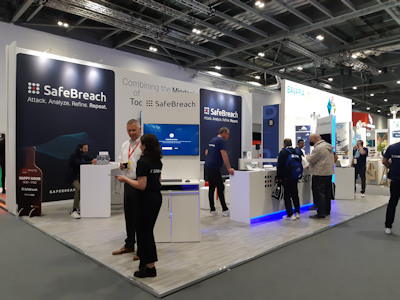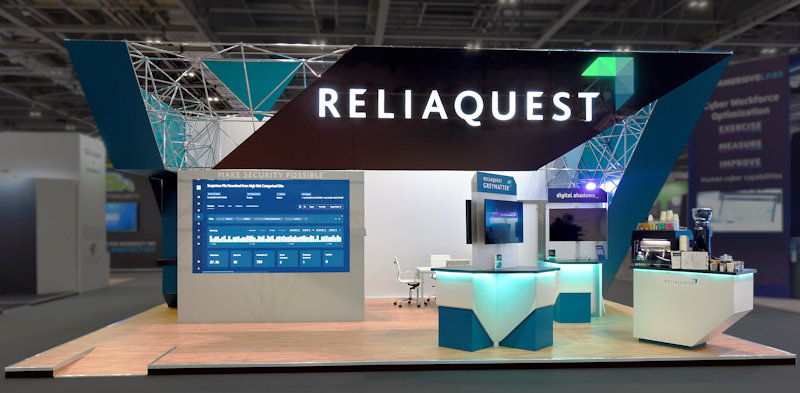
Planning to exhibit in the United Kingdom? Jolly good! But keep in mind, even if you’re speaking the same language, you’re probably not speaking the same exhibiting vernacular. The British exhibition landscape is filled with peculiarities, from shell schemes and GDPR to sustainability and risk assessments. Particularly if you’re new to U.K. exhibiting, there’s a lot to wrap your head around.
But here’s the silver lining: The U.K. exhibition scene is remarkably well-organized and professional. Once you learn the ropes, it’s as straightforward as afternoon tea.
So let’s take a quick look at the least you need to know to make your U.K. exhibition debut a smashing success. Grab a cuppa and let’s dive in.
Exhibit Types
First things first: Forget everything you know about “booths.” In the United Kingdom, you’ll be working with “stands,” and they’re measured in square metres rather than square feet. While Americans work comfortably in 10-by-10-foot increments, Brits think in 3-by-3-meter modules.
Second things second: In many other countries, you rent a specific size footprint in which to position your exhibit, and it typically comes with nothing more than the concrete under your feet. You then fill that space with a custom or rented booth that typically doesn’t come from the show itself. The British system offers this same option—known as space only—but shows also allow you to rent various booth systems to complement your floor space.
Here are common stand options to consider:
- Shell Schemes: Sold in square meters, shell schemes are typically modular constructions with white panels and aluminum frames. They often stand 2.4m to 2.5m high and include carpet, company and booth identification, and various walls depending on your configuration. Additionally, some shell schemes include lights, electrical outlets, and furniture. Some shows also offer hybrid solutions, which are a combination of rental components and custom elements.
While shell schemes seem like standard offerings, variations by show, venue, and contractors abound. So before you sign on the dotted line, check your contract to ensure your expectations and their deliverables are a perfect match.
- Space Only Footprints: Space only means just that. You’re buying the space on the show floor with no bells and whistles whatsoever. This option—which is sometimes referred to as raw space—typically allows structures up to 4 meters in height without special permission from the organizer. Exhibitors can often engage their own contractors for the build, but once again, a host of variations mean it’s critical to read the fine print.
- Bespoke: Bespoke packages represent the Rolls-Royce of U.K. exhibition solutions, offering a comprehensive turnkey approach that goes beyond mere stand construction. These all-inclusive packages typically combine design, build, and show services into one seamless offering. Your package might encompass graphic design services, AV equipment rental, furniture selection, and even hospitality planning. Plus, some proper bespoke solutions include elements that many exhibitors might not even consider—from pre-show marketing integration to post-show storage solutions.
Setup, I&D, and Dismantling Differences
The British approach to show setup is refreshingly straightforward compared to the U.S. union system. But don’t mistake this informality for a lack of professionalism. British build teams operate with remarkable efficiency. They just do it with more tea breaks and less red tape.
That said, it’s important to carefully review the show manual to determine exactly what is and isn’t allowed. For example, some shows will divide up service responsibilities between official providers and your preferred crew. It’s up to you as the exhibitor to determine who’s allowed to perform what tasks during setup.
On the whole, build times are typically shorter compared to the United States and some other international venues, with most shows allowing just one or two days for setup compared to the generous three or four days common elsewhere. So the pace is brisk but civilized, with strict attention paid to health and safety regulations. Additionally, every contractor needs proper certification, and working hours are religiously observed, including those essential tea breaks.
Height Restrictions
Height restrictions in U.K. venues are nuanced, with regulations varying significantly between venues and even within different halls of the same facility. While the standard maximum height for space-only stands typically sits at 4 metres (approximately 13 feet), venues like ExCeL London and the NEC Birmingham often allow greater heights in specific zones.However, if you want to extend above this 4 meter average, you’ll likely need to adhere to strict standards and approval processes involving particulars like structural endorsements and static calculations.
The real complexity lies in the venue-specific regulations: The Olympia London, for instance, has varying height restrictions based on your location relative to its historic glass ceiling, while Manchester Central enforces different limits depending on whether you’re exhibiting in the Central Hall or the Exchange Hall.
Double-deck stands face additional scrutiny, requiring structural calculations, detailed technical drawings, and often an independent structural engineer’s approval. However, shell scheme stands are also strictly regulated and usually capped at the aforementioned 2.4 or 2.5 metres.
It’s worth noting that any stand exceeding the standard height limits must submit plans well in advance—typically 6-8 weeks before the show—and may incur additional fees for structural sign-off.
Ordering Electrical
Here’s where things can get properly complicated. The United Kingdom’s 230V/50Hz system means U.S. equipment won’t simply plug and play. You’ll need proper transformers and adapters, and all electrical work must be certified to BS7671 standards.
Don’t even think about trying to save a few quid by using multiplug adapters. Each piece of electrical equipment needs its own properly rated socket, and all installations must be carried out by authorized personnel. Plus, as a general rule, it’s better to order more power than you think you’ll need, as running short could leave you in a pickle.
Additionally, running cabling under carpet is prohibited. You can, however, run it atop the carpet if you employ a special cable cover that allows for people to easily and safely traverse it.
And as a side note, the size of electrical plugs in the U.K. means you’ll need to give a little extra thought to cord management. And since you’re not allowed to daisy-chaining devices together, you’re going to have a considerable amount of electrical plugs and outlets, all of which you’ll likely want to conceal.
Ordering Other Services
Your show manual will help you or your exhibit partner order services such as cleaning, security, plumbing, catering, additional furniture, photography, and the like. Additionally, many U.K. shows are beginning to offer data retrieval/lead management.

ExCel London is home to Infosecurity Europe, Europe’s leading cyber security event. Exhibiting is SafeBreach, who offers a deeper insight into threat exposure and a more comprehensive view of cyber risk.
Most major venues work with official contractors, which are preferred suppliers who handle everything from catering to waste management, and venues often mandate the use of their approved suppliers for certain services. Rigging, catering, and cleaning services must typically be ordered through the venue’s preferred suppliers, while other services like furniture rental and graphics might allow third-party vendors.
The real trick lies in the timing: Early-bird discounts can save upwards of 20 to 30% on service costs. However, these deadlines are strictly enforced, usually falling 4 to 6 weeks before show opening. The exhibitor manual (or “exhibition manual” in British parlance) becomes your bible here, containing not just ordering forms but also crucial information about delivery windows, loading bay booking systems, and specific contractor requirements.
Also keep in mind that you can rarely place major service orders on site. For example, if you forgot to order a genie lift to place your overhead sign, you’re out of luck, as attempting to place that order during setup is an exercise in futility.
GDPR Considerations
General Data Protection Regulation (GDPR) compliance at U.K. exhibitions isn’t merely a box-ticking exercise. It’s a fundamental requirement that carries hefty penalties for non-compliance.
The aim of GDPR is to give individuals more control over how their personal data is used and for businesses to be more transparent in how that data is processed. But for exhibitors, this can mean rethinking lead-capture and data-collection processes. Every business card collected, every badge scanned, and every contact form filled must be accompanied by explicit consent for data processing and storage. So you’ll need clear privacy notices at every data collection point, whether digital or physical, explaining exactly how you’ll use the information, how long you’ll keep it, and who you’ll share it with.
The rules extend to photography and video recording at your stand, so visible signage must inform visitors if they’re being recorded. Many U.K. organizers now require exhibitors to submit their GDPR compliance strategy as part of the show documentation, and some even mandate specific data processing agreements with their official lead capture providers.
Overwhelmed? Don’t be. Check out this handy cheat sheet for the basics, or take a deep dive with this guide from the Information Commissioner’s Office.
Risk Assessments
Risk assessments are legally mandated documents that require meticulous attention to detail under the Health and Safety at Work Act 1974 and the Management of Health and Safety at Work Regulations 1999. Every exhibitor, regardless of stand size or complexity, must submit a comprehensive risk assessment that identifies potential hazards and outlines specific control measures.
For shell schemes, you’ll need to assess risks from activities like using step-ladders to hang graphics or managing electrical cables. Space-only stands require additional documentation, including detailed method statements (i.e., Risk Assessment Method Statements, aka RAMS) that outline the setup and dismantling procedures step by step.
Double-deck stands face particularly rigorous scrutiny, requiring structural calculations and often an independent structural engineer’s sign-off. The assessment must consider everything from trip hazards and working at height to fire risks and crowd management.
Venues typically require these documents four to six weeks before the show, and many won’t allow build-up to commence without approved assessments on file. The consequences of inadequate risk assessments can be severe, ranging from delayed stand construction to complete prohibition of certain activities or, in extreme cases, stand closure.
Detail-Level Differences
While the fundamentals of trade shows might seem universal, the devil, as they say, is in the details. And British exhibitions have their own distinct quirks that sets them apart. Here are a few more considerations to keep in mind.
- Smaller shows, bigger networking. The United Kingdom’s premier venues, such as London’s ExCeL and Birmingham’s NEC, might not rival the sprawling expanses of Las Vegas or Chicago, but they offer something distinctly different: a more intimate, relationship-focused environment and a tighter focus on networking.
- Start times and off-floor networking. The rhythm of British trade shows differs markedly from their American counterparts. Shows typically start mid-week rather than over weekends, and networking continues well after hours in nearby pubs and restaurants, where some of the best deals are struck.
- Sustainability requirements. Sustainability isn’t just a buzzword in British exhibitions. The U.K.’s commitment to environmental standards means your stand design needs to consider recyclability, energy efficiency, and waste reduction. Many venues now require detailed sustainability plans as part of the application process.
- Shipping and customs. The U.K.’s exit from the European Union has added layers of complexity to the import process. You’ll need comprehensive carnets for temporary imports, and every piece of wood packaging must meet ISPM15 standards. Working with an experienced freight forwarder is essential.
Successfully exhibiting in the United Kingdom doesn’t require a complete reinvention of your exhibition strategy, but it demands careful attention to detail. That’s where companies like Idea International come in. With decades of experience, we speak the global language of exhibitions fluently.
Whether you need help with stand design that meets U.K. regulations, assistance navigating customs requirements, or guidance on cultural nuances, our team of global exhibition experts can ensure your U.K. show presence is spot on. Contact Idea International today to learn how we can help make your next British exhibition a proper success.



Comments are closed.